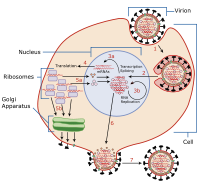List of latent human viral infections
|
Virus latency (or viral latency) is the ability of a pathogenic virus to lie dormant () within a cell, denoted as the lysogenic part of the viral life cycle. A latent viral infection is a type of persistent viral infection which is distinguished from a chronic viral infection. Latency is the phase in certain viruses' life cycles in which, after initial infection, proliferation of virus particles ceases. However, the viral genome is not fully eradicated. The result of this is that the virus can reactivate and begin producing large amounts of viral progeny without the host being infected by new outside virus, denoted as the lytic part of the viral life cycle, and stays within the host indefinitely.
Virus latency is not to be confused with clinical latency during the incubation period when a virus is not dormant.
Episomal latency refers to the use of genetic episomes during latency. In this type, viral genes are stabilized floating in the cytoplasm or nucleus as distinct objects, both as linear or lariat structures. Episomal latency is more vulnerable to ribozymes or host foreign gene degradation than provirus latency.
One example is Herpes Virus family, Herpesviridae, all of which establish latent infection. Herpes virus include Chicken-pox virus and Herpes simplex viruses (HSV-1, HSV-2), all of which establish episomal latency in neurons and leave linear genetic material floating in the cytoplasm. The Gammaherpesvirinae subfamily is associated with episomal latency established in cells of the immune system, such as B-cells in the case of Epstein-Barr Virus. In the case of Herpes simplex (HSV), the virus has been shown that it fuses with DNA in neurons, such as brain cells, and HSV reactivates upon even minor chromatin loosening with stress, although the chromatin compacts (becomes latent) upon oxygen and nutrient deprivation.
...
Wikipedia

